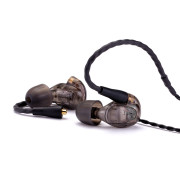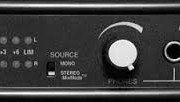10 Reasons your In-Ear System Sucks and What to Do About It
Many churches have made the transition to in-ear monitors. From a musician’s point of view, the results vary. Some have found a solution that empowers musicians to play their best, while reducing the stage volume and overall volume in their sanctuary. Others struggle to make in-ears work for their musicians.
Few of us have the budget to execute an in-ear system on the level of a national touring act. However, there are a number of minimum requirements that need to be in place with an in-ear system in order to create the conditions for your musicians to be comfortable and play at their best. Here’s the thing: as loud as stage monitors are, they are much easier to implement and operate than in-ear monitors. If the conditions are not right for a decent stereo in-ear mix for each musician, then you should consider ditching your in-ear system and going back to stage monitors. Musicians, if you can’t depend on the in-ear mix, and you feel compelled to keep one ear out, then this article is for you! Here are ten common issues that might lead your musicians to think that in-ears suck and what you can to do about them. Let us know what’s on your list or how you’ve overcome your unique in-ear challenges.
- You’re using consumer ear buds. Consumer buds, even ones advertised as in-ears, are not designed to
 be used in loud band environments. They lack the needed attenuation of sounds in the room and the ability to reproduce balanced music in your ear canal. Professional In-Ear monitors, whether Universal Fit or Custom Molded, are essential to the experience. Professional In-Ear monitors are designed by audiologists and touring monitoring professionals to accomplish two goals: (1) Provide 15~25dB of acoustic attenuation so you can protect your ears from the high sound pressure levels in the room, (2) Provide a clean, balanced reproduction of the music inside your ear canal. ACTION: Upgrade to 2-way or better Universal Fit In-Ear monitors.
be used in loud band environments. They lack the needed attenuation of sounds in the room and the ability to reproduce balanced music in your ear canal. Professional In-Ear monitors, whether Universal Fit or Custom Molded, are essential to the experience. Professional In-Ear monitors are designed by audiologists and touring monitoring professionals to accomplish two goals: (1) Provide 15~25dB of acoustic attenuation so you can protect your ears from the high sound pressure levels in the room, (2) Provide a clean, balanced reproduction of the music inside your ear canal. ACTION: Upgrade to 2-way or better Universal Fit In-Ear monitors. - The gig lacks a dedicated monitor engineer or the ability for musicians to control their own mix. You’re at the mercy of a sound operator whose primary job is to handle the house mix. When he’s got a moment, you’ll struggle to communicate with him to get the critical change you need to hear yourself. In the professional world, a dedicated & trained engineer would monitor each band member’s mix and watch for visual signals from band members needing adjustments. Or there would be a local Aviom, MyMix or ME-1 style distributed monitor mix system so you could make adjustments on your own. ACTION: Demand a dedicated monitor engineer or personal monitor mixers. If its not meant to be, ditch the in-ears.
- You’re listening in mono. Maybe that’s all that’s available or perhaps you didn’t know you could pan the monitoring into
 stereo. Hearing in stereo is a wonderful thing. It allows us to locate sounds in a space and distinguish particular sounds or conversations from the noise around us. Pan vocal and other instruments hard left and right to make space for your vocal and instrument in the middle. You’ll be able to hear yourself better and run at a lower volume. ACTION: Every musician needs to run in stereo. Implement wired in-ears, personal monitor mixers, get a console with enough busses, or ditch your in-ear system.
stereo. Hearing in stereo is a wonderful thing. It allows us to locate sounds in a space and distinguish particular sounds or conversations from the noise around us. Pan vocal and other instruments hard left and right to make space for your vocal and instrument in the middle. You’ll be able to hear yourself better and run at a lower volume. ACTION: Every musician needs to run in stereo. Implement wired in-ears, personal monitor mixers, get a console with enough busses, or ditch your in-ear system. - Things aren’t completely mic’d up. If you’re going to make in-ears work, you’ll need a line from every instrument, as well as the drums and overheads. Some sound engineers cut microphones, because they won’t need them in their house mix. But that hi-hat or ride cymbal may be the very thing you depend on to keep time. So mic it up. ACTION: Mic it all up, even if you don’t need it at FOH.
- Your monitor mix is dependent on the channel gain settings of the house mixing console. Every time the house engineer makes a change, it affects your monitor mix. And now you’ve got to get his attention to
 get back to the happy place you momentarily experienced. Professional monitor systems are designed to ensure that levels remain stable for the artist. There are two solutions: (1) A separate monitor console with dedicated mic preamps, or (2) A committed sound check procedure that ensures that channel gain settings are never adjusted after a line check. ACTION: Get the right gear for in-ears or go back to stage monitors. If you have to share input gain, then stick to a procedure that sets gain at the line check then locks it down for the entire gig.
get back to the happy place you momentarily experienced. Professional monitor systems are designed to ensure that levels remain stable for the artist. There are two solutions: (1) A separate monitor console with dedicated mic preamps, or (2) A committed sound check procedure that ensures that channel gain settings are never adjusted after a line check. ACTION: Get the right gear for in-ears or go back to stage monitors. If you have to share input gain, then stick to a procedure that sets gain at the line check then locks it down for the entire gig. - Your mix is muddy and it’s tough to discern the individual instruments. Sound Operators are trained to get up and running first then make it sound pretty later. They will start with channel gain then cut straight to getting you the signals you need in your mix. If your mix is muddy and they’re using a digital console, then there’s a simple fix that will dramatically clean up your in-ear mix. Ask them to engage and turn up the HPF on each channel as far as they can without adversely thinning out the sound of the instrument. This will clean up the muddiness and clarify your mix. ACTION: Kindly ask your engineer to use their HPF’s to clean up the bottom end of the mix.

- The vocals are bone dry. Without a bit of reverb, lead singers my feel like they’re in an echo chamber, which is a very uncomfortable place to be as a vocalist. A separate Reverb for each lead vocalist keeps the mixes clean and creates a cozy environment for them to get comfortable. ACTION: Ask your engineer to implement a reverb for each lead singer.
- You feel disconnected from the congregation. If you’re pulling your ears out to hear the congregation, then its time to invest in some ambient room mics. We prefer shotgun mics on stage, pointed at the congregation, to get it done. Work them into your mix so you can hear the congregation when the band breaks it down. ACTION: Add a pair of shotgun style ambient mics.
- You have old or low cost wireless in-ears. Not all wireless systems are created equal. Older or low cost system can introduce all sorts of problems that affect your ability to lead or perform your best. Issues like drop
 outs, harshness, collapsed stereo, audible compression, distortion, hiss, etc. all impact your ability to lead and perform at your best. Some monitor engineers don’t listen with a wireless belt-pack, so they may not be hearing the problems you’re hearing. If you’re having issues, raise a flag right away. ACTION: Upgrade to quality wireless systems from Shure, Sennheiser or AKG or switch to wired systems.
outs, harshness, collapsed stereo, audible compression, distortion, hiss, etc. all impact your ability to lead and perform at your best. Some monitor engineers don’t listen with a wireless belt-pack, so they may not be hearing the problems you’re hearing. If you’re having issues, raise a flag right away. ACTION: Upgrade to quality wireless systems from Shure, Sennheiser or AKG or switch to wired systems. - You can’t hear everything as well as you could when you used to use stage monitors. I’m often surprised at how poor of an in-ear mix some musicians seem willing to tolerate. A great in-ear mix should sound like a studio recording, with you nestled in the mix or on top of it – just how you like it. ACTION: Bring in a mix engineer with studio experience whom you respect. Have them dial in the console and then share their mix with everyone. Tweak to your instrument and vocal levels from there.
If you’re tired of suffering with poor quality in-ear mixes, reach out to the good folks at Kungpow. We’d be happy to help you and your tech team implement a system and process that will ensure great in-ear mixes for your musicians and worship leaders.









